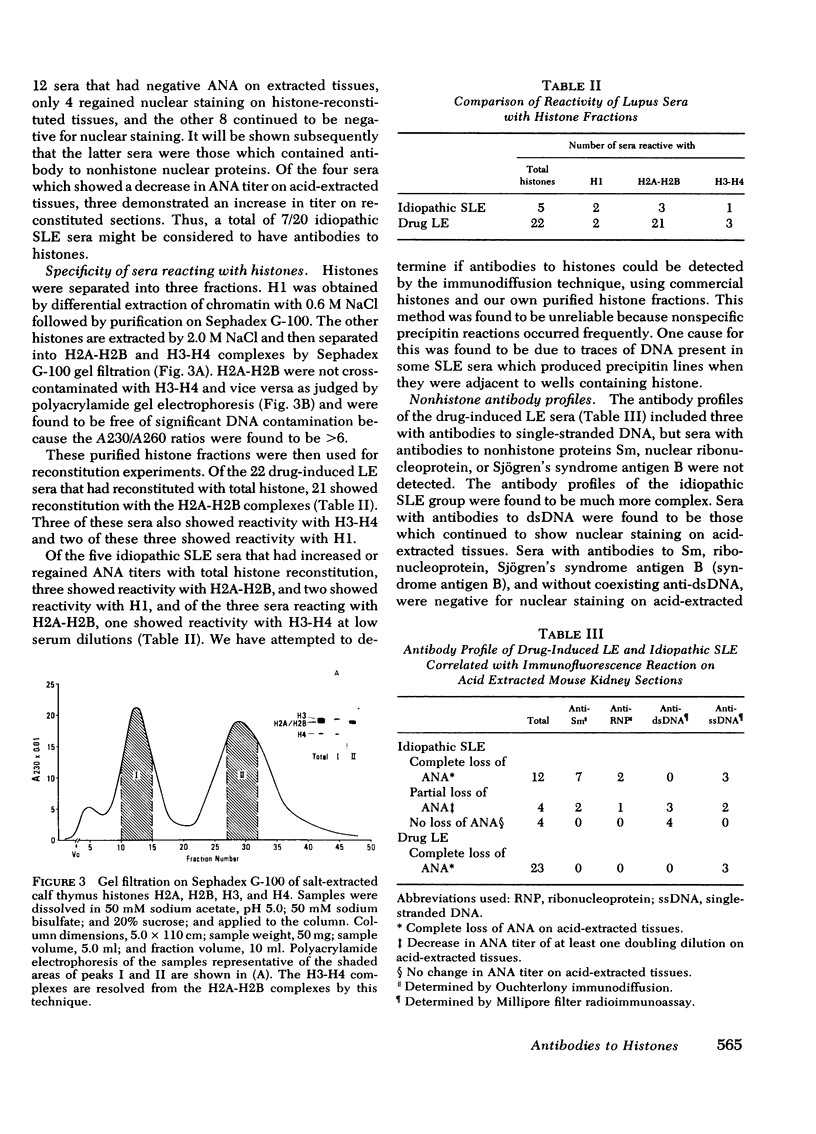Abstract
When tissue sections are extracted with 0.1 N HCl, cellular nuclear proteins, including histones, are removed but nuclear DNA is retained. Histones can be reconstituted back to nuclear DNA in acid-extracted tissue sections so that the resulting nuclear substrate is composed only of DNA and histones and does not contain acidic nuclear protein antigens. The resulting DNA-histone tissue substrate can be used in the immunofluorescent method for specific detention of antibodies to histones. Sera from 23 patients with drug-induced lupus erythematosus (procainamide 19, isoniazid 2, nitrofurantoin 2) and 20 patients with idiopathic (not drug-induced) systemic lupus erythematosus (SLE) were studied. All 23 patients with drug-induced lupus erythematosus (LE) lost nuclear staining on acid-extracted sections. In contrast, only 12 of 20 with idiopathic SLE lost nuclear staining on acid-extracted tissues, and in the remaining 8, there was no significant fall in titer. In the drug-induced LE group, loss of nuclear staining was due to the absence of histones on the substrate because with histone-reconstituted sections, 22 of 23 again became positive for nuclear staining at titers equal to or at one doubling dilution below titers on unextracted tissues. In contrast, of the 12 idiopathic SLE sera which lost nuclear staining, only 5 regained nuclear staining on histone-reconstituted tissue sections. In idiopathic SLE, antinuclear antibodies are heterogeneous in specificities and may consist of antibodies to native DNA, histones, or nonhistone proteins. In contrast, antinuclear antibodies in drug-induced LE are less heterogeneous and mainly consist of antibodies to histones.
Full text
PDF







Images in this article
Selected References
These references are in PubMed. This may not be the complete list of references from this article.
- ALLFREY V. G., LITTAU V. C., MIRSKY A. E. METHODS FOR THE PURIFICATION OF THYMUS NUCLEI AND THEIR APPLICATION TO STUDIES OF NUCLEAR PROTEIN SYNTHESIS. J Cell Biol. 1964 May;21:213–231. doi: 10.1083/jcb.21.2.213. [DOI] [PMC free article] [PubMed] [Google Scholar]
- Alspaugh M. A., Tan E. M. Antibodies to cellular antigens in Sjögren's syndrome. J Clin Invest. 1975 May;55(5):1067–1073. doi: 10.1172/JCI108007. [DOI] [PMC free article] [PubMed] [Google Scholar]
- BICKIS I., VON BERTALANFFY L. Identification of cytoplasmic basophilia (ribonucleic acid) by fluorescence microscopy. J Histochem Cytochem. 1956 Sep;4(5):481–493. doi: 10.1177/4.5.481. [DOI] [PubMed] [Google Scholar]
- Berlowitz L., Pallotta D., Pawlowski P. Isolated histone fractions and the alkaline fast green reaction. J Histochem Cytochem. 1970 May;18(5):334–339. doi: 10.1177/18.5.334. [DOI] [PubMed] [Google Scholar]
- Camerini-Otero R. D., Sollner-Webb B., Felsenfeld G. The organization of histones and DNA in chromatin: evidence for an arginine-rich histone kernel. Cell. 1976 Jul;8(3):333–347. doi: 10.1016/0092-8674(76)90145-8. [DOI] [PubMed] [Google Scholar]
- Frommhagen L. H. The solubility and other physicochemical properties of human gamma-globulin labeled with fluorescein isothiocyanate. J Immunol. 1965 Sep;95(3):442–445. [PubMed] [Google Scholar]
- Ginsberg B., Keiser H. A Millipore filter assay for antibodies to native DNA in sera of patients with systemic lupus erythematosus. Arthritis Rheum. 1973 Mar-Apr;16(2):199–207. doi: 10.1002/art.1780160210. [DOI] [PubMed] [Google Scholar]
- HOLMAN H., DEICHER H. R. The reaction of the lupus erythematosus (L.E.) cell factor with deoxyribonucleoprotein of the cell nucleus. J Clin Invest. 1959 Nov;38:2059–2072. doi: 10.1172/JCI103984. [DOI] [PMC free article] [PubMed] [Google Scholar]
- Hekman A., Sluyser M. Antigenic determinants on lysine-rich histones. Biochim Biophys Acta. 1973 Feb 21;295(2):613–620. doi: 10.1016/0005-2795(73)90059-7. [DOI] [PubMed] [Google Scholar]
- Hnilica L. S. Methods for analysis of histones. Methods Enzymol. 1975;40:102–138. doi: 10.1016/s0076-6879(75)40011-8. [DOI] [PubMed] [Google Scholar]
- Kornberg R. D., Thomas J. O. Chromatin structure; oligomers of the histones. Science. 1974 May 24;184(4139):865–868. doi: 10.1126/science.184.4139.865. [DOI] [PubMed] [Google Scholar]
- Mihalakis N., Miller O. J., Erlanger B. F. Antibodies to histones and histone-histone complexes: immunochemical evidence for secondary structure in histone 1. Science. 1976 Apr 30;192(4238):469–471. doi: 10.1126/science.3853. [DOI] [PubMed] [Google Scholar]
- Ohlenbusch H. H., Olivera B. M., Tuan D., Davidson N. Selective dissociation of histones from calf thymus nucleoprotein. J Mol Biol. 1967 Apr 28;25(2):299–315. doi: 10.1016/0022-2836(67)90143-x. [DOI] [PubMed] [Google Scholar]
- Panyim S., Chalkley R. High resolution acrylamide gel electrophoresis of histones. Arch Biochem Biophys. 1969 Mar;130(1):337–346. doi: 10.1016/0003-9861(69)90042-3. [DOI] [PubMed] [Google Scholar]
- Perry H. M., Jr, Tan E. M., Carmody S., Sakamoto A. Relationship of acetyl transferase activity to antinuclear antibodies and toxic symptoms in hypertensive patients treated with hydralazine. J Lab Clin Med. 1970 Jul;76(1):114–125. [PubMed] [Google Scholar]
- Picazo J. J., Tan E. M. Specificities of antibodies to native DNA. Scand J Rheumatol Suppl. 1975;11:35–41. doi: 10.3109/03009747509095627. [DOI] [PubMed] [Google Scholar]
- Stollar B. D. Reactions of systemic lupus erythematosus sera with histone fractions and histone-DNA complexes. Arthritis Rheum. 1971 Jul-Aug;14(4):485–492. doi: 10.1002/art.1780140408. [DOI] [PubMed] [Google Scholar]
- Tan E. M. An immunologic precipitin system between soluble nucleoprotein and serum antibody in systemic lupus erythematosus. J Clin Invest. 1967 May;46(5):735–745. doi: 10.1172/JCI105574. [DOI] [PMC free article] [PubMed] [Google Scholar]
- Tan E. M. Drug-induced autoimmune disease. Fed Proc. 1974 Aug;33(8):1894–1897. [PubMed] [Google Scholar]
- Tan E. M. Relationship of nuclear staining patterns with precipitating antibodies in systemic lupus erythematosus. J Lab Clin Med. 1967 Nov;70(5):800–812. [PubMed] [Google Scholar]
- Weintraub H., Palter K., Van Lente F. Histones H2a, H2b, H3, and H4 form a tetrameric complex in solutions of high salt. Cell. 1975 Sep;6(1):85–110. doi: 10.1016/0092-8674(75)90077-x. [DOI] [PubMed] [Google Scholar]
- Winfield J. B., Koffler D., Kunkel H. G. Development of antibodies to ribonucleoprotein following short-term therapy with procainamide. Arthritis Rheum. 1975 Nov-Dec;18(6):531–534. doi: 10.1002/art.1780180601. [DOI] [PubMed] [Google Scholar]
- van der Westhuyzen D. R., von Holt C. A new procedure for the isolation and fractionation of histones. FEBS Lett. 1971 May 20;14(5):333–337. doi: 10.1016/0014-5793(71)80294-6. [DOI] [PubMed] [Google Scholar]




